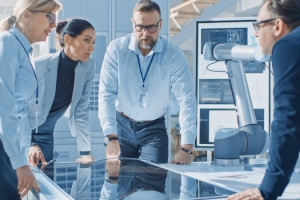


Trends I published 15 December 2023
Ecommerce
E-commerce is booming and plays an increasingly important role in the European construction, installation, and home improvement markets. E-commerce offers retailers, wholesalers, suppliers, and manufacturers opportunities to generate more customers and sales as consumers get more used to the convenience of ordering online.
To gain insights into the current status, growth, and effect of e-commerce in the construction, installation, and home improvement markets, USP Marketing Consultancy conducts several studies per year. These quantitative and qualitative studies all show that e-commerce is here to stay and that there are still many opportunities to be grasped.
How is it already impacting the industry?
The digital maturity of the construction and installation markets is lagging compared to the home improvement market. However, the vast majority of construction and installation companies will invest more in their e-commerce policies. This is mainly due to the continuous demand of customers, a fundamental change in how the industry orders, and the realisation that the sector is indeed lagging.
Drivers of E-commerce in construction and installation
When it comes to e-commerce in construction, organisations increasingly know exactly what they want. In essence, the biggest wish is a solution to the data problem so that e-commerce can be used without any problems. It is also important to reduce manual data errors. This strong focus on streamlining activities and saving time makes sense in light of the growth that the construction sector has experienced.
While most industry organisations are in the early or mid-stage of the e-commerce curve, many distributors are in a more mature phase. The urgency for distributors to embrace innovation may lie in the rise of direct sales to consumers. Distributors are more likely to be forced to digitalize due to the threat posed by manufacturers and wholesalers selling directly to consumers.
BIM also drives e-commerce growth
However, even the most mature e-commerce organisations in construction are still lagging behind sectors such as retail. Growth in construction will take place partly due to the need for Building Information Modeling (BIM). BIM has changed in recent years from a nice-to-have solution for on-site productivity to a digital model that is at the heart of organisations’ digitalization plans—a model that building material companies will increasingly rely on to succeed.
Omni-channel is becoming the new norm
The traditional way of separating trade channels is increasingly disappearing in European countries, not only in the B2C market but also in the B2B market. In the past, manufacturers only supplied their products to professional traders or wholesalers (general and specialised). These channels sold the products to professionals. Today, the decision-making process is much more complicated than it was decades ago, and online buying options are numerous. This development has led to a switch from the traditional three-layer model to the current dynamic model.
Changing search and purchase behaviour of professionals
The growth of e-commerce strengthens the online search and purchasing behaviour of professionals. This is not surprising, as e-commerce offers many benefits for professionals. The speed of ordering, delivery, and cost savings are very important advantages, for example, as construction projects need to be delivered faster and faster.
How has e-commerce impacted online search and purchasing behaviour?
- Architects regularly use online resources to stay up-to-date with trends and new solutions. They also search the internet a lot for technical product properties. They widely use the internet in general, and specifically the websites of manufacturers and platforms for architects, as sources of information.
- Contractors expect the share-of-wallet of pure online stores to strongly grow in the coming years. At the moment, pure online stores have a fairly low share (between 1% and 6%) compared to other channels. The UK and the Netherlands are the frontrunners with the highest expected increase, mainly due to distinctive features, fast delivery services, and convenient ordering methods.
| Share of contractors buying from pure online stores | |||||||
| UK | Germany | France | Poland | Belgium | Netherlands | Spain | |
| Current share | 57% | 27% | 5% | 21% | 12% | 18% | 10% |
| Expected share in 5 years | 82% | 40% | 12% | 30% | 27% | 48% | 17% |
- The vast majority of installers buy their products online, regardless of the channel. However, there is a big difference between the E-installers and the HVAC-installers. This difference is mainly due to the types of products that can be ordered online.
Buying from pure online shops is slow in most countries. For example, the share-of-wallet installers dedicated to pure online shops is around 4 to 5 per cent. In times of busy schedules and a lot of work for the installation companies, we see that they tend to go back to their traditional product suppliers where the most necessary materials can be found.
| Share of installers buying online, regardless of channel | |||||||
| UK | Germany | France | Poland | Belgium | Netherlands | Spain | |
| E-installer | 87% | 89% | 56% | 68% | 81% | 92% | 50% |
| HVAC-installer | 51% | 59% | 22% | 27% | 43% | 76% | n/a |
E-commerce in the home improvement sector
The online share of home improvement purchases in Europe has grown from 8.5% in 2019 to 13.2% in the first half of 2020. Although DIY stores are growing in sales this year, they are losing market share to the online channel. Established players must therefore defend themselves against the risk of e-commerce and utilise the opportunities e-commerce supplies.
Amazon is more often the starting point in the online journey
Online stores as a starting point for the purchase of home improvement products is a worrying development for hardware and DIY stores. In most countries, consumers prefer Amazon as a starting point when buying specific home improvement products. This is worrying because in this case, the DIY store may not be a point of contact at all in the customer journey. This will lead to DIY stores rapidly losing market share, which can have negative consequences in the long run if DIY spending returns to normal.
What is next?
As customer satisfaction is increasingly important in the business operations of retailers, wholesalers, suppliers, and manufacturers, customers are increasingly spoiled. As a result, customer expectations increase and they require:
- Cheap or free returns
- No shipping costs
- A website where information about products can easily be found
- 24/7 low response online customer service
- A frictionless buying experience by phone and computer
Handling more customer data to gain an edge over the competition
Data is becoming increasingly important. By selling products through your webshop, a huge amount of data is collected. Based on this data, the offer can be adjusted to what the customer wants. Besides, over the past 5 years there has been a huge increase in voice-activated devices like Amazon Echo and Google Home, leading to a parallel leap in consumers who want to try voice commerce. As more voice-activated devices appear on the market, this trend will only continue to accelerate.
In B2C, Augmented Reality (AR) and Virtual Reality (VR) are a growing trend, focusing on delivering an inspiring and immersive customer experience. There are also great possibilities to use AR and VR in B2B, such as offering the right parts or custom designs.
We are already seeing B2C companies taking a step towards reducing their environmental impact. This includes highlighting the impact of certain actions on their customers. Sustainability matters especially to millennials, which is important as these people are the next CEOs who might be interested in your product.
Context is key
To create an overview of market developments and provide context for client-specific research, USP Marketing Consultancy has developed several monitors. We continuously research market developments and effects of key trends like labour shortage among architects, contractors, HVAC installers, electrical installers, painters and end-consumers, of which reports are published quarterly, semi-annually or annually.

Read more about the subject

Fresh Insights Await
Our latest reports
Delve into the newest findings across various market segments, crafted for a cutting-edge overview. Explore our latest reports, brimming with up-to-date data, trend analyses, and in-depth examinations, all tailored to provide you with a comprehensive understanding of the current market dynamics.
Construction
Home Improvement
Installation












